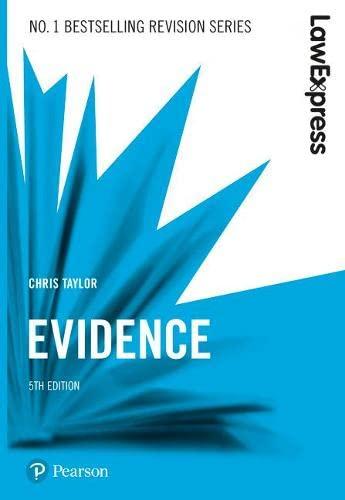Question
Note: use the IRAC approach to answer the question (see below) Q: Mary is 29 and works for Crunch Ltd., a food manufacturer, as a
Note: use the IRAC approach to answer the question (see below)
Q: Mary is 29 and works for Crunch Ltd., a food manufacturer, as a production line worker.A Federal Award sets out her pay and conditions.The pay is poor, so in an effort to 'get ahead' Mary has also worked part-time as a topless barmaid for several years.More recently, she has applied for promotion to the position of production line supervisor at Crunch.
Over the years, Mary has endured many tasteless remarks about her large breasts from the male workers at Crunch. A few weeks ago, on her birthday, Mary received a card from the male staff at Crunch.It pictured a nude woman serving drinks to men with their tongues hanging out.She was deeply offended and immediately told Andrew, her immediate superior, showing him the card.
He laughed at Mary, commenting that she must get a lot of similar cards.Mary then asked him to tell the male workers to apologise, and to train the men in appropriate workplace behaviour.He refused saying that he was sure the other workers hadn't meant to offend.He added that if she could not get along with the other workers, then 'there isn't much future for you at Crunch'.The following day, Mary learnt that her application for promotion had been refused.
Has Mary been sexually harassed or victimised as those terms are defined in the Sex Discrimination Act 1984 (Cth) so as to allow her to seek a remedy for remedies under the Act from the male staff involved, Andrew or Crunch? Would your answer be different if the conduct had not occurred during normal work hours at Crunch's premises but after hours at the Office Christmas Party, held at a nearby hotel? Why or why not? (25 marks) (You are not required to consider whether Mary has also been discriminated against on the basis of her sex)
THE 'IRAC' APPROACH TO ANSWERING LAW PROBLEM QUESTIONS
A law problem question will give you a set of facts and ask you to advise one or more parties on their legal position. Any answer which clearly shows that you understand the relevant law and how it applies to the facts of the question will earn you top marks.One way of demonstrating your knowledge is by using the IRAC approach (but this approach is not compulsory):
1.Identify the legal issue raised by the question
This can be done by the use of headings or by posing a question.For example, is there a valid contract between A and B?
2.State the relevant legal rule (giving authority, i.e. case or statute)
This step lays the foundation necessary for you to answer the question you have posed in step 1.You will set out the relevant law, referring to the section(s) of a statute or the case(s) which contain the legal rule.(It may not always be sufficient to refer to statute law alone.You may also need to refer to case law explaining the meaning of the words or phrases used in the statute)
3.Apply the law to the facts of the question
You have cited certain statute or case law in step 2 for a reason.You have done so because the facts presented to you in the question have brought to mind the statute or case.What you must do now is show a link between the facts of the question and that statute or case law.
You need to explain why the legal rule or principle established by the statute or case law should be applied to the facts of the question (be sure to fully explain your reasoning).If referring to statute law, you should explain how each element of the statutory provision (or section of the statute) has been satisfied.If referring to case law, you must highlight the similarities between the facts of the precedent case and the facts of the question. Alternatively, you may wish to highlight one or more important differences between the precedent case and the facts before you, in order to explain why, on closer analysis, the legal rule established by that case should not apply on the facts set out in the question.
4.Come to a conclusion
In this step you should sum up what you have said in steps 2-3, before saying what you think is the correct answer to the question posed in step 1.
It is likely that before you can answer the general legal issue raised by the question, you will need to address a number of more specific legal issues.For that reason you will normally need to go through these steps several times (or more) in the course of an answer - that is identify a legal issue, set out the relevant law, apply the law to the facts of the question before concluding on that issue and then going on to the next issue if there are several distinct issues. (Source: Business Law by A Ardagh, Butterworths, 2001). In other words, you should not have one section of your answer setting out all the legal issues raised by the question, followed by one section setting out all the relevant law and so on - that will make it difficult for the marker to follow your reasoning.
Step by Step Solution
There are 3 Steps involved in it
Step: 1

Get Instant Access to Expert-Tailored Solutions
See step-by-step solutions with expert insights and AI powered tools for academic success
Step: 2

Step: 3

Ace Your Homework with AI
Get the answers you need in no time with our AI-driven, step-by-step assistance
Get Started


